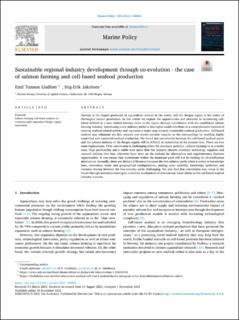| dc.contributor.author | Lindfors, Emil Tomson | |
| dc.contributor.author | Jakobsen, Stig Erik | |
| dc.date.accessioned | 2022-03-07T08:49:43Z | |
| dc.date.available | 2022-03-07T08:49:43Z | |
| dc.date.created | 2021-11-05T15:01:36Z | |
| dc.date.issued | 2021 | |
| dc.identifier.citation | Lindfors, E. T., & Jakobsen, S.-E. (2022). Sustainable regional industry development through co-evolution - the case of salmon farming and cell-based seafood production. Marine Policy, 135:104855. | en_US |
| dc.identifier.issn | 0308-597X | |
| dc.identifier.uri | https://hdl.handle.net/11250/2983316 | |
| dc.description.abstract | Norway is the largest producers of aquaculture salmon in the world, and the Bergen region is the centre of Norwegian salmon production. In this article we explore the opportunities and obstacles in introducing cell-based seafood as a new related industry niche in the region through coevolution with the established salmon farming industry. Introducing a new industry niche to this region could contribute to a comprehensive renewal of existing seafood-related activity and represent a major step towards sustainable seafood production. Cell-based seafood may eliminate sea lice, escapee and excess nutrient impacts on the surroundings by enabling highly controlled and contained seafood production. We found that coevolution between the cell-based seafood sector and the salmon industry in the Bergen region will be difficult to materialize at the present time. There are two main explanations. First, coevolution is challenging when the dominant path (i.e., salmon farming) is in a stable state. High profitability and a stable state mean that this industry absorbs investors, technology suppliers and research milieus that may otherwise have been on the lookout for alternatives and supplementary business opportunities. It also means that incumbents within the dominant path will not be looking for diversification alternatives. Secondly, there are distinct differences between the two industry paths when it comes to knowledge base, innovation mode and geographical configurations, making actor mobility, knowledge spillovers and resource sharing between the two industry paths challenging. We also find that coevolution may occur in the future through industrial convergent evolution mechanisms of downstream value chains as the cell-based seafood industry matures. | en_US |
| dc.language.iso | eng | en_US |
| dc.publisher | Elsevier | en_US |
| dc.rights | Navngivelse 4.0 Internasjonal | * |
| dc.rights.uri | http://creativecommons.org/licenses/by/4.0/deed.no | * |
| dc.title | Sustainable regional industry development through co-evolution - the case of salmon farming and cell-based seafood production | en_US |
| dc.type | Peer reviewed | en_US |
| dc.type | Journal article | en_US |
| dc.description.version | publishedVersion | en_US |
| dc.rights.holder | © 2021 The Author(s). | en_US |
| dc.source.volume | 135 | en_US |
| dc.source.journal | Marine Policy | en_US |
| dc.identifier.doi | 10.1016/j.marpol.2021.104855 | |
| dc.identifier.cristin | 1951888 | |
| dc.source.articlenumber | 104855 | en_US |
| cristin.ispublished | true | |
| cristin.fulltext | original | |
| cristin.qualitycode | 1 | |

